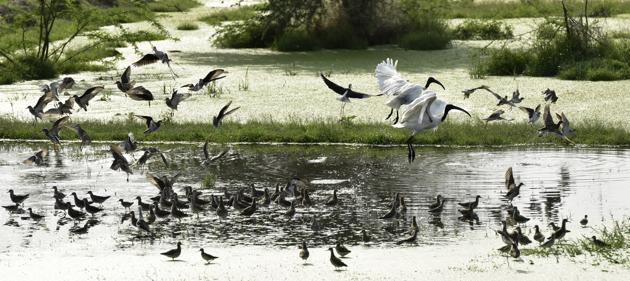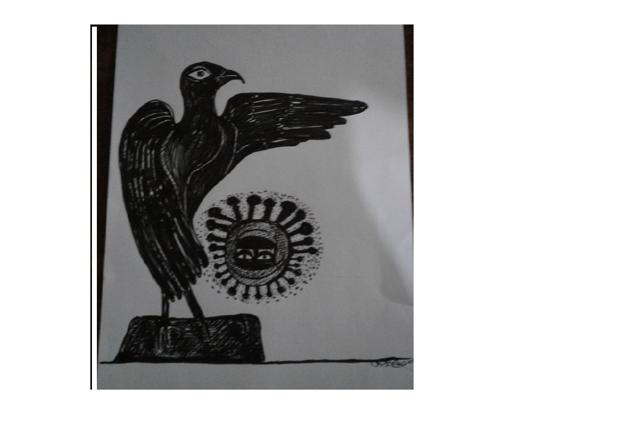Lockdown Diaries: Flying Around by Esther David
Earlier, birdwatching was not on the author’s list of things to do but things have changed
In the days following the announcement of a lockdown because of the corona virus in India, I would see the images of the virus relayed everywhere, so I concentrated on its design. When enlarged, this dangerous virus resembles a sculpted sphere from which a thousand poisonous starfish emerge like a crown of thorns. Why does it look like an invisible predatory piranha or sea anemone, waiting with open jaws to swallow us all? One particular day, I was shocked as I opened the newspaper and saw a photograph of a man wearing a helmet designed like the virus. He was smiling and my imagination took over, and I felt that if I were to wear this bizarre surrealistic Covid-19-shaped headgear, I would have a stroke. It scares me. Agreed, this is no time for imaginative imagery or symbolism. But I don’t have other things to do, because with just this one announcement, I felt shackled for life.

So far, every single day, I would leave my house, find an auto and whizz around Ahmedabad, either on an errand or for a cup of chai in the Old City, or I would head to a café with my laptop to write. Now, instead, I had to learn to stay home. Once the housework was done, after making some chapattis, along with a little gardening in my green patch, what was I to do? I would listen to music or watch food shows on television for company, or sit ruefully in front of my laptop, trying to write an article for a food magazine, while worrying about my daughter and her family in Paris.

I gave myself another task – that of writing a love story like Gabriel Garcia Marquez, ‘Love in the Time of Coronavirus’. But there was no scope for creativity either, as I was looking for essentials, which were ‘looted’ in advance and had to manage with my limited resources, even as I was given a list of phone numbers, which were not helpful. Finally, a young friend sent me all that I needed. I thanked her and told her, “It was never so bad in the worst of times, even when swarms of locusts attacked Ahmedabad, or the riots, or the earthquake.”
But let’s move on to more positive things. Earlier, bird-watching was not on my list of things to do during the day. But since the lockdown, my mornings have changed, as I hear birdsong, which gives a good start to the day. Suddenly, with the absence of human beings and rumble of vehicles, if you can turn a deaf ear to the barking of stray dogs and observe the birds around you, it will bring you closer to nature. The birds around homes and housing societies are becoming daring, unafraid of coming closer. If you look carefully and listen to their calls, you will see that they are all over the place. Even squirrels are boldly running around and giving final touches to their nests in secret corners, which are woven with spun strings, shredded textiles, pieces of cotton, moss and dry grass.
The other day, a sun bird flew into my ground-floor apartment when the door was open; then feeling rather confused, it made a U-turn and flew away. A friend told me the babblers are now outnumbering the pigeons around her housing society. Crows and swallows are also seen as babblers fly around in groups or have a leisurely sand-bath in a children’s playground. And when she is in the kitchen, making her first cup of coffee, swallows fearlessly sit on her kitchen windowsill or knock on the windowpanes with their beaks and make her smile. Behind her apartment building there is an unused green zone, where a flock of black ibis roost on a tree. From her balcony, she watches the ibis and many other birds flying amidst the foliage or nesting in the trees.

To continue the bird story, last week, a young friend living in a tenement opened her front door and saw a sparrow. Excitedly, she called out, “I just saw a sparrow,” as she believes sparrows are an endangered species. She quickly closed the door so as not to frighten the bird perched on a branch of the mogra creeper she had planted next to the main door. Since then, every morning, she leaves bowls of grains and water for the sparrow, so that it continues to visit her and eventually feels inspired to make a nest in the foliage of the fragrant mogra.
I now spend my mornings watching the aerial gliding of sun birds, along with bulbuls, robins, mynahs, babblers and flowerpeckers. If I am lucky, I also see a stray egret or starling. Since the lockdown, in this still silence around me, I can hear the distant cries of kingfisher, coppersmith, koel and peafowl, as kites and falcons patrol the skies, looking for prey down below on earth. The other day, someone saw a common green bee-eater, a drongo and a shrike.
Every morning, I study a flowering bush close to my bedroom window, disturbing a few butterflies flitting over the flowerbeds. As they disappear, I look for the nest a pair of tailor birds is making in one of the broad-leafed plants, stitching the leaves into a cozy nest for their brood. And to add colour to our surroundings, during the sleepy mid-afternoon hours, a flock of wild Indian parrots arrive to perch on a young neem tree, chattering away, maybe about the sudden silence which has descended upon a world predominantly inhabited by human beings. The closeness between wildlife and us humans is increasing. I try to decipher the hidden meaning of these birdsongs, as we have a lot to learn from nature, because as they say, “Nature is a great educator…”
Esther David is the author of Bombay Brides published by HarperCollins






